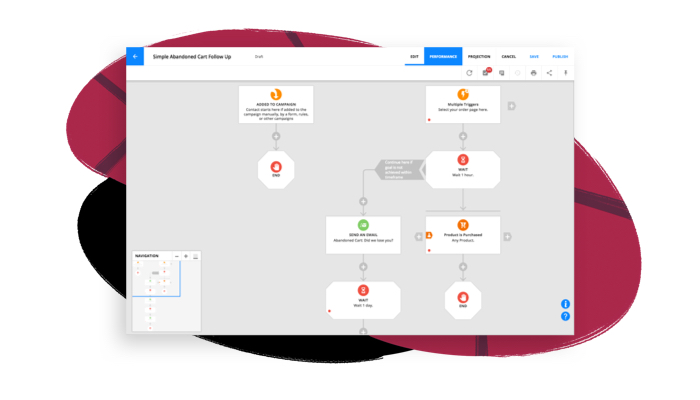The ability to keep leads engaged not only benefits you as a business owner, but it also makes customers feel more connected to your brand. In fact, the more engaged contacts are throughout the customer lifecycle, the more likely they are to become loyal to your brand.
According to research by Gallup, engaged customers tend to buy more and are more likely to tell their friends about your brand.
While creating an engaging customer experience for your brand does take nurturing over time, there are ways you can use automation to simplify the process. Here are five ways you can use a marketing automation platform like Ontraport to keep your contacts engaged at every phase of the customer lifecycle:
1. Retargeting: Attract phase
Before marketers were able to cookie site visitors’ browsers, any potential lead who opted not to fill out a brand’s web form, request a consultation or purchase a product was a lost cause. By adding tracking scripts to your pages, you can retarget your would-be lost opportunities on platforms such as Facebook, Google, Bing, Twitter, and more. This means you can show ads for your abandoned product or incomplete form to prospects as a reminder to come back and complete their purchase or opt-in.
While retargeting is especially useful for new leads who are not yet in your CRM database, you’re not limited to only retargeting new contacts. It also works for upsells and cross-sells later on in the customer lifecycle.
Some examples of potential pages on which to set up retargeting are:
- Webinar registration pages
- Appointment reminder ads
- Order pages (abandoned orders)
- Marketing emails or blog content
- Membership site course pages
- Event registration pages

2. Cold lead re-engagement: Convert phase
A good portion of leads who enter your sales funnel aren’t ready to commit to a purchase and may not be for some time. The nature of a long sales cycle might leave you with many disengaged leads. This is why continuously nurturing your leads to keep them engaged is so important.
In Ontraport, you can launch a lead re-engagement campaign that automatically identifies your cold leads and gradually regains their interest through a series of personalized, nurturing emails. Through the use of tracking pixels that you place on your web pages, Ontraport can detect when a contact hasn’t visited your website, bought from you, clicked on your content or engaged with you in other ways after a certain period of time.
Targeted to appropriate segments of your list, cold-lead nurturing ensures that you stay top-of-mind with your leads, pulling them back into your sales funnel with content marketing and other strategic calls to action until they’re ready to buy.
Here are a few examples of offers you can include in your own re-engagement campaigns:
- Free content such as existing ebooks or templates
- Contests or giveaways
- Discounts
- Live webinars
- Surveys
- Referral bonus
3. Product usage and customer service programs: Fulfill phase
Have you ever purchased a product or service and been impressed by the memorable level of care and attentiveness the brand gave you afterward? Companies like Zappos, Sephora and Amazon have mastered post-purchase engagement, and there’s a lot to be learned from their examples. The main takeaway? Customer relationships don’t end post-purchase; they’re just beginning.
There are many ways you can use your Ontraport account or marketing automation software to strengthen the post-purchase customer experience, including:
- Automated delivery or confirmation emails that fire immediately after purchase or opt-in
- Bonus content or offers that automatically send in the weeks after purchase
- Related upsell or cross-sell offers
- For a more complex product or service, automated invites to schedule onboarding calls
- Automated task reminders to follow through with any scheduled onboarding calls
If you’re looking for additional ways to give your customer service a boost, you may also want to consider:
- Creating a Facebook group to engage your customers
- Regularly replying to social media comments and shoutouts
- Replying to reviews on your product or service whenever applicable
- Customer service standards that the entire company follows

4. Cart abandonment: Delight phase
Statistics show that customers who have purchased from you before are likely to come back for more. Smile.io says, “After one purchase, a customer has a 27% chance of returning to your store. While that’s not a horrible return rate, if you can get that customer to come back and make a second and third purchase they have a 54% chance of making another purchase.” A great way to nudge existing customers who come back to shop on your site, but don’t follow through with their purchase, is to set up a cart abandonment follow-up campaign.
All you have to do is set up a messaging funnel in your automation software account that’s designed to encourage cart abandoners to return. You can use email, SMS or a combination of the two, and the messages should be spaced out over the course of three days. Consider the reasons your prospects may have abandoned their purchases. Maybe it was confusion about how to complete checkout, or maybe they didn’t feel secure giving you their information.
Your first message, to be sent within an hour of cart abandonment, should defuse these objections: “If you had trouble checking out or found something confusing, please contact our helpful customer support department. Click here to finish shopping.”
Your second message, to be sent on the second day, should create some urgency. Inform the shopper that their items are “on hold.” Consider including a deadline as a little nudge. “It looks like you have items waiting for checkout! Click here to finish your order before they sell out.”
If the sale hasn’t been completed by the third day, send one last message with a follow-up offer. This is your final chance to convert the sale, so make it something worthwhile such as free shipping with their order or a 20% discount on their entire order form.
Looking for additional ways to reclaim lost sales with cart abandonment follow-up? Here are a few examples:
- Retargeting: While this strategy can be used on existing customers, retargeting also opens the door for you to reach leads whose contact information isn’t yet in your database.
- Discount: Do your customers need the extra push to complete their purchase? Try offering them a personalized coupon code.
- Sales call: If you’re selling a higher-ticket item, picking up the phone and calling your cart abandoners could be your best bet. You can set your Ontraport account to drop these contacts into a lead router so your sales team can follow up.
- Downsell: Is high cost deterring your leads? If contacts abandon a cart full of your top-tier products, try offering them an entry-level version of those items or services whenever possible.
- Abandonment lightbox: Instead of waiting for your customers or leads to leave the page altogether, try adding a lightbox to your order page that displays on exit intent. In Ontraport, you can set lightboxes to appear the moment a mouse cursor charts a course for the exit button.
To build a cart abandonment funnel in your Ontraport account, you can use the free “Simple Abandoned Cart Follow-up” template in Campaign Marketplace. Simply fill in the blanks and publish the campaign.
5. Surveys: Refer phase
A survey is used to garner feedback with the goal to obtain testimonials or other valuable insights about your business from the perspective of your leads or customers. While it’s possible to reach out to your list one-by-one via email, as your business grows, that will become expensive and time-consuming.
An automated customer feedback survey created in your Ontraport account solves this problem. It opens a direct line of communication with your customers at scale using an email asking them to click to fill out a survey, which takes them to a landing page with a survey form.
By understanding exactly what your customers like and dislike about your product or service, you can begin to make improvements to better meet the needs of your customers — and attract new customers. You can also use the positive feedback as testimonials on your homepage or sales pages and on social media, paid ads, or even to help boost your SEO.
Here are two examples of automated feedback surveys you can create in Ontraport or your marketing automation platform:
- Service call feedback: Rather than calling clients for feedback a few days after a service call, add them to an automated funnel to handle the process for you. After the call, simply update your CRM with any necessary information and mark your service call task “complete” to trigger an automated email to your clients.
- Post-purchase: Drive customers to keep purchasing from you by delivering a post-purchase survey to their inbox complete with an incentive: 20% off their next purchase.
Have more ideas on how to keep contacts engaged throughout the customer lifecycle? Share them in the comments below.
